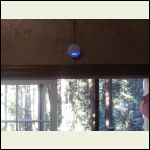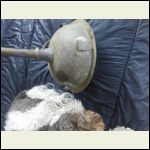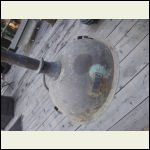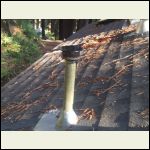| . 1 . 2 . >> |
| Author |
Message |
paulz
Member
|
# Posted: 15 Jul 2022 10:01pm - Edited by: paulz
Reply
I've had a CO detector in the cabin for several years, never gone off, green light blinks every so often like it's supposed to. Never had any symptoms other than fatigue, which I always have anyway, and an occasional mild headache before morning coffee.
I got curious whether the thing is still good so brought out the detector from my house. Sure enough, beep beep beep after cooking dinner on the two burner propane cook top.
Hmm, well I have another detector back at the city house so I brought that one out too. Same thing, beep beep beep. Original cabin one still quiet.
Next I bought a 'CO test kit' a little round dingus that turns black if CO is present. It did. I should add that there is a window directly above the cooktop, and an open sliding glass door 12' away on the opposite wall. I wasn't always opening these in winter but do most of the time.
Next step, I bought a new detector, put it up today, sitting above the sliding glass door like the others. This one has a readout that comes on when it detects and tells you the PPM. As you can see it's reading 85 in the photo, and has gone over 100 in the one meal I've cooked, door and window open. It does go back down afterward. Does the temporary rise in CO cause for concern?
I'm a bit surprised with all the ventilation, and apparently need to do something. I do have a plan.. sort of. Got this old bras spittoon or whatever it is. And I had the forethought, incredibly, to put a vent pipe in the wall right above where the cooktop is. Maybe add a fan..
Some of you that cook or heat with unvented propane might want to consider one of these detectors. And btw, neither the wall heater nor woodstove, both of course vented, set off the detector.
20220715_171926_1..jpg
| 
20220715_184449.jpg
| 
20220715_184515.jpg
| 
Screenshot_2022071.png
|
|
|
ICC
Member
|
# Posted: 15 Jul 2022 11:08pm - Edited by: ICC
Reply
Your propane range, cooktop or whatever you use may be able to be adjusted to burn more completely and that will mean less CO production.
CO detectors have a limited life span, as you have found out. I like the ones that come with a built-in non-rechargable lithium battery. When it comes to end of life it beeps and you toss it and replace with a new one. The battery never gets changed.
A problem that is run into a lot with part time use cabins is that the battery runs out during a period of no use. Happens a lot with cabins used only in summer or 3 seasons. If the batteries go bad in the period of extended no occupancy no one is there to hear it beep. By the time people return the battery has gone so flat the beeper doesn't even work. If somebody does not actively check the unit they may think it is still fine.
Virtually all propane or natural gas appliances produce CO. Some tests have shown that gas ranges almost always increase CO levels and frequently to levels well above the points considered safe. Gas ranges and cooktops and stoves should always be used with a ventilation hood operating. One that exhausts the air to the outside not a recirculation type.
That was one reason why when I built the new place I went with an induction cooktop. More efficient than the usual electric range elements and more efficient than gas. Also very controllable. And pricey and need magnetic cookware to work. But no more CO.
Since you have a vent pipe in the wall I would get a good range hood and vent outside whenever the range is used.
The CO increase in the room may be sort of temporary but your blood hangs on to it for hours after the source is turned off. CO has a half-life of 4 to 5 hours. (Data is somewhat variable). That is, after 4 to 5 hours one-half of whatever amount of CO was in your blood will still be there.
Also, remember that the hemoglobin in blood has a greater affinity for CO than oxygen. CO binds 250 times more strongly to hemoglobin than oxygen. So I don't like to mess around with the odds of surviving CO poisoning.
|
|
ICC
Member
|
# Posted: 15 Jul 2022 11:11pm
Reply
Headaches are one of the earliest signs of CO poisoning.
|
|
paulz
Member
|
# Posted: 15 Jul 2022 11:27pm
Reply
Quoting: ICC The CO increase in the room may be sort of temporary but your blood hangs on to it for hours after the source is turned off. CO has a half-life of 4 to 5 hours.
Yes, I remember reading that. Definitely time to make use of that vent pipe. I have doubts that my rare morning headaches are CO related, my wife never gets them and she's in the cabin constantly, plus I don't cook after 6pm. Just the same, no sense in being exposed at all.
My cooktop is the ceramic unit I have raved about. I love it, no open flame, better heat distribution etc., but I'm now curious if it's more of a CO producer than an open flame.
I have one of those indoor Buddy Heaters, use it during the morning bathroom visit in winter, I'm curious what the detector will think of that.
|
|
gcrank1
Member
|
# Posted: 16 Jul 2022 09:09am
Reply
Do CO detecters have an increased lifespan if the bats are removed between visits?
|
|
ICC
Member
|
# Posted: 16 Jul 2022 01:26pm
Reply
Quoting: gcrank1 Do CO detecters have an increased lifespan if the bats are removed between visits?
The sensor degrades over time even if not being used or powered.
FYI, the test button on a CO detector only tests the electronics, it does not test whether or not the sensor actually can sense CO. There are test aerosol cans purpose made for testing the operation of the sensor. And note that it is a poor idea to place a CO at an auto exhaust tailpipe as a test. The exhaust contains moisture and other gases that may harm the sensor as well as being hot which may cause damage.
Change at least every 5 years is what I go by.
|
|
gcrank1
Member
|
# Posted: 16 Jul 2022 09:50pm
Reply
Well, I guess it is better to be safe than dead
And 'life insurance' aint
|
|
paulz
Member
|
# Posted: 17 Jul 2022 12:48pm
Reply
Quoting: ICC There are test aerosol cans purpose made for testing the operation of the sensor.
Yeah saw that, $40 a can, which granted should last as long as the propellant does. But the new detector was $10. 
|
|
|
toyota_mdt_tech
Member
|
# Posted: 17 Jul 2022 07:43pm
Reply
I just replaced my detector, mine is the smoke, CO and Radon. Mine has a battery, I do test it often, my home had only smoke, I replaced them both with smoke and CO, I have an aging furnace and planning on a replacement within a year.
Paulz, look for a nice blue flame, burning most efficient, we dont want a yellow flame or a yellowish flame.
Also, generators, I run mine and when its running, that window closest to it (only one on that side of cabin) make sure that window is closed.
|
|
paulz
Member
|
# Posted: 17 Jul 2022 10:38pm - Edited by: paulz
Reply
Tonight I cooked with the window and slider closed on purpose, front door open, to see what would happen. Meter went up to 150 PPM and it set off the alarm, not good. Opened everything up and cleared it out.
|
|
toyota_mdt_tech
Member
|
# Posted: 19 Jul 2022 08:30am - Edited by: toyota_mdt_tech
Reply
Quoting: paulz Meter went up to 150 PPM
Well, that would explain the brain damage. 
Kidding of course Paul. 
Be thankful you became aware of it and correcting it.
Nothing worse then waking up dead.
|
|
gcrank1
Member
|
# Posted: 19 Jul 2022 09:39am
Reply
Wonder how many home kitchens with gas stoves would trigger one?
|
|
ICC
Member
|
# Posted: 19 Jul 2022 10:23am
Reply
Two references to read
Iowa State University
EPA: What is the average level of carbon monoxide in homes?
|
|
gcrank1
Member
|
# Posted: 19 Jul 2022 10:45am
Reply
There are two points I question in the Iowa report.
As I understand it, Carbon Dioxide and Water Vapor are Not pollutants.
|
|
paulz
Member
|
# Posted: 19 Jul 2022 11:29am
Reply
Good reads ICC. I wonder about my infrared cook top. There is no blue flame, only the orange glow, like a buddy heater. Does it put out more CO than an open flame cooktop?
Started de-crusting what I'm going to attempt as a hood. Have to open up the wall and find the vent pipe I put in.
|
|
Tim_Ohio
Member
|
# Posted: 19 Jul 2022 11:55am - Edited by: Tim_Ohio
Reply
I've often thought of CO as a useful tool as I age. I nick-named my cabin the "suicide shack", thinking I might like to off myself when I find I'm not satisfied with life anymore, instead of laying in a bed, incapacitated, toward the end. I'm even planning on attracting my favorite birds, the turkey buzzards, to be around so I can be of some use as a meal for something that can keep living...chuckles.
Tim_Ohio
|
|
gcrank1
Member
|
# Posted: 19 Jul 2022 02:02pm
Reply
There is no waste in nature
|
|
ICC
Member
|
# Posted: 19 Jul 2022 02:59pm - Edited by: ICC
Reply
Quoting: gcrank1 There are two points I question in the Iowa report. As I understand it, Carbon Dioxide and Water Vapor are Not pollutants.
From the report: "At higher concentrations CO2 can cause drowsiness, headache, and lead to a “stuffy†feeling in a home. Excess water vapor can lead to problems with mold, wood rot, and peeling paint."
Perhaps the term pollutant is interpreted differently by different people. As defined by the OECD: "A pollutant is a substance that is present in concentrations that may harm organisms (humans, plants and animals) or exceed an environmental quality standard. The term is frequently used synonymously with contaminant."
Unlike CO, which is not good for us in any concentration there are many substances which vary in how dangerous or toxic they are depending on their concentration. Too much oxygen can be detrimental to human health. Too much oxygen can lead to cell death in the lungs as well as cause other severe, even catastrophic results. Anyone who scuba dives will, or should, know about hyperoxia, an excess of oxygen in body tissues. Some scuba mixes have more oxygen than the normal surface air concentration for specific uses. There is an O2 percentage, maximum depth and time relationship that must be followed. Deep dive mixes reduce the concentration of O2. Helium is introduced to the mix as if O2 is simply removed, that raises the concentration of nitrogen to the level where that level becomes narcotic to the human body.
So, anyhow, too much CO2 in an indoor environment can also be bad for a human. It is not as serious as having high CO levels, but can be detrimental to health.
Quoting: Tim_Ohio I've often thought of CO as a useful tool as I age. I nick-named my cabin the "suicide shack", thinking I might like to off myself when I find I'm not satisfied with life anymore,
I believe we should have that as a right.
FWIW, CO is used in a number of industrial processes.
FYI, one of the best sources of CO for offing oneself is to light a charcoal fire in a grill indoors with doors and windows closed tight. Or use helium gas in a (non-)breathing hood. The lack of O2 after a few minutes or rebreathing will result in unconciousness and eventual death. But if one messes up they may survive but be more or less brain dead.
|
|
gcrank1
Member
|
# Posted: 19 Jul 2022 03:37pm
Reply
Plants take in CO2 and create Oxygen.
Afaik, there is no Fed 'non-safe level' of CO2 specified, so how can it be a pollutant.
As for Water Vapor, we dont even have to go there (roll eyes).
Words have meaning, one would think especially in academia. It just seems to me that an official publication from a university does itself no service by using the wrong words in a report. Makes me wonder.....
However, that nit-pick said, the CO thing is a real-deal problem, imo far more commonly dangerous than suspected. But then, so is pumping gas.
Lots out there to get us.
|
|
ICC
Member
|
# Posted: 19 Jul 2022 06:48pm
Reply
Quoting: gcrank1 Afaik, there is no Fed 'non-safe level' of CO2 specified, so how can it be a pollutant.
There are USDA standards for FSIS (Food Safety & Inspection Service) employees concerning CO2 exposure because they can be exposed to high CO2 levels in some food processing plants, but that is not connected to the general everyday life of most people.
Workers in dry ice plants or wherever dry ice is used can be exposed to high levels. I learned that from a nephew who worked in an ice cream factory that shipped ice cream products to remote areas in northern Canada as a summer job. They used insulated corrugated cardboard boxes with a layer of dry ice packed on top of the ice cream.
|
|
paulz
Member
|
# Posted: 3 Aug 2022 05:27pm - Edited by: paulz
Reply
I've been cooking with the doors and window above the cooktop open, no alarms. Won't do for winter though, so I've opened up the wall and found the 2" vent pipe I put in. I need to come off that with a 45 or a 90, and put a cover plate over it on the wall, like an escutcheon or roof jack type thing, they must make them, what are they called?
|
|
gcrank1
Member
|
# Posted: 4 Aug 2022 09:23am
Reply
Maybe take a look at what the boat folks use?
|
|
DryCreek
Member
|
# Posted: 6 Aug 2022 09:26am
Reply
Just FWIW, when we bought one of the early monoxide detectors a couple decades ago, it had a display that would display even 1 PPM. When we got an apparently identical one a couple of years later that had changed it so it displayed 0 until the reading hit 50 PPM.
The one that would display single digits was useful because you could look for incipient problems.
I'm not aware of any of the current consumer alarms with displays that will display single digit readings.
I looked for 'monoxide meter' on amazon and there are handheld meters that might do that. There are a bunch of no-names for $20 to $30 that might work, and a 'Klein Tools ET110' for $100 that presumably would work. I just gave the specs a quick scan; before you get any of them make sure they will actually display low concentrations.
|
|
paulz
Member
|
# Posted: 8 Aug 2022 11:50am - Edited by: paulz
Reply
Yeah I don't think my new one displays a reading until it's worry time.
I'm still in mock up on the vent but here's the plan. Found some old stainless flex muffler tubing in my stash. Need some clamps, and polish that brass thing a friend gave me. Also ordered a little battery powered fan I hope I can stick up inside and will survive.
Scrounge engineering at it's finest..
|
|
gcrank1
Member
|
# Posted: 8 Aug 2022 07:56pm
Reply
Look good for a MkI proof of concept trial 
|
|
paulz
Member
|
# Posted: 9 Aug 2022 10:59am
Reply
Thanks. I'm going to buff that brass on my floor standing buffer, but first it has to work. No idea how directly above the burner it has to be to suck out the CO. I'm just super happy I had the forethought to put that pipe through the top plate and roof when I built the place, usually don't think that far ahead. 
|
|
ICC
Member
|
# Posted: 9 Aug 2022 06:58pm
Reply
You are on the right track with a vent for the range. But I wonder how much good the 2" diameter pipe will do. The efficacy also depends on the CFM volume of the fan you have coming.
A standard range hood for a gas range is calculated on the BTU output of the burners. Add the BTU's up and divide by 100. The result is the CFM recommended for a gas range. Now that is also to vent heat as well as steam and CO. Less air flow should still help the CO reduction, but how much is the question.
|
|
paulz
Member
|
# Posted: 9 Aug 2022 07:14pm
Reply
Yeah I've wondered too. It's actually 2-1/4", and only about 8'. I normally only run one burner. I guess the CO alarm will tell the story when I try it with all the doors and windows shut.
|
|
paulz
Member
|
# Posted: 16 Aug 2022 11:58am
Reply
Almost done, still need to mount the fan and a wall plate. Polished the brass, about as good as this kludge assembly is going to look. And speaking of kludge, I was looking at vent caps online and saw something that looked like what I have in my motorcycle parts stash. A Triumph air cleaner without the paper.
20220816_084908.jpg
| 
20220816_08434411.jpg
|  |  |
|
|
gcrank1
Member
|
# Posted: 16 Aug 2022 01:22pm
Reply
Think I remember reading about the cfm rating for a hood/vent is based on all the burners and oven/broiler going? We also only run one burner for the two of us, just dont need multiple going for the simple cabin fare we serve.
|
|
| . 1 . 2 . >> |

